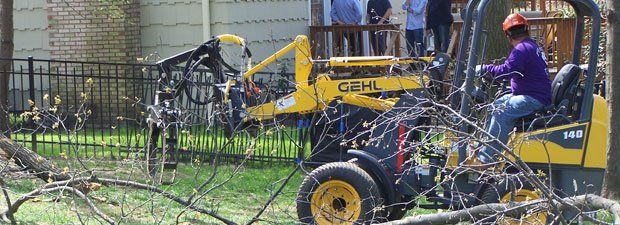Are My Trees Safe?
Have your trees been examined by a Licensed Tree Expert lately?
Trees in your landscape need to be treated as the asset they are. Trees increase the property value of your land, clean the air we breathe, reduce water pollution, provide shade which can decrease your energy bills and can make your home and neighborhood more attractive. However trees as they mature and grow larger, or are neglected, improperly cared for or damaged by construction activities can cause potentially hazardous and dangerous conditions. Your trees become a liability instead of an asset. Fortunately, most hazardous conditions in your trees can be prevented through proper care.
Mickiewicz Arbor Experts, LLC
is here to help!
Trees, just like people need periodic examinations-inspections to recognize potential problems and actions to address these situations. Because of their nature and size you can never remove all risks associated with trees, however by identifying these potential risks and mitigating them you can reduce risk to acceptable levels. Early detection can prevent expensive remedies and/or badly damaged property or personal injury. This will increase the safety of your property and help improve your trees health and longevity.
Potential Risks, What to look for:
- Dead, dying, structurally weak or overextended branches.
- Dead branch hangers.
- Co-dominant trunks and/or trunks with V-shaped attachments.
- Presence of decay in branches or trunk.
- Lightning damage.
- Insufficient rooting space.
- Early leaf change or defoliation.
- Presence of mushrooms or conks on tree, base of trees or in area of root zone.
- Root flare not present, (area of transition from trunk to roots).
- Presents of insects or disease associated with trees.
- Soil compaction (silent killer).
Once risks are identified there are number of actions which we can recommend.
- Move or remove the target: A target is any person or property that could potentially be damaged or injured by a failed tree part or tree. If there are no targets present there is no risk and the tree would not be considered a hazard even if it was likely to fail at any time. A tree in a forest away from people or property is not considered a hazard. Unfortunately large structures like houses or sheds can not be moved. Picnic tables, cars and even swing sets can be moved to another location to eliminate the hazard.
- Pruning: Pruning is recommended to address certain situations. Removing dead, dying, damaged, structurally weak or defective branches. Overextended branches can sometimes be reduced. Pruning to improve trees structure is always important.
- Cabling and bracing: Cabling and bracing can be used alone or in conjunction with pruning. They are intended to reduce risk of failure of weak branch attachments and/or multiple stems. In bracing a threaded rod is secured through the branches or trunk near the point of attachment. Cabling uses galvanized cable and are attached with through bolts in the upper portion of the tree.
- Routine maintenance: Trees need proper periodic care. As your trees mature this is even more important. Besides proper pruning, trees need proper mulching to protect the root zone and keep line trimmers and lawn mowers away from the tree. Trees may need the addition of nutrients and at times of drought additional irrigation.
- Tree removal: Tree removal should be the last resort. Some trees the risk is to great and should be removed.
